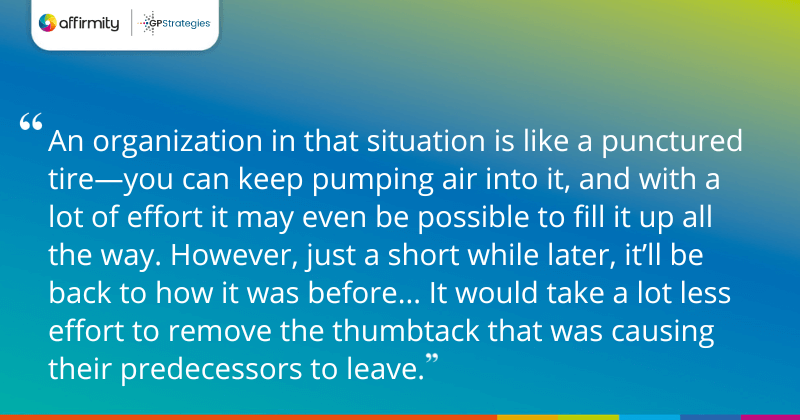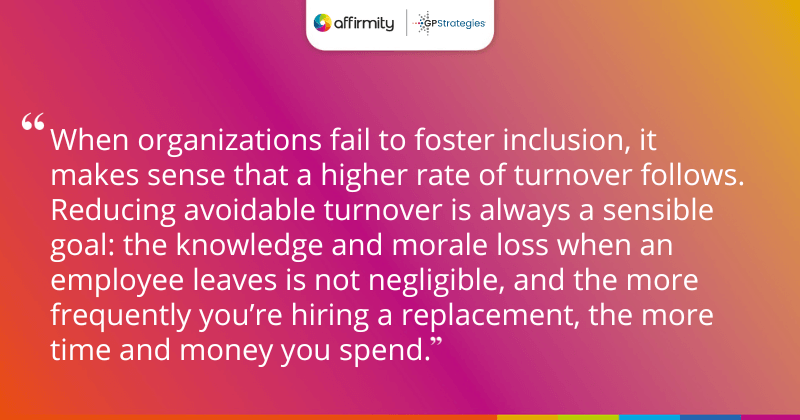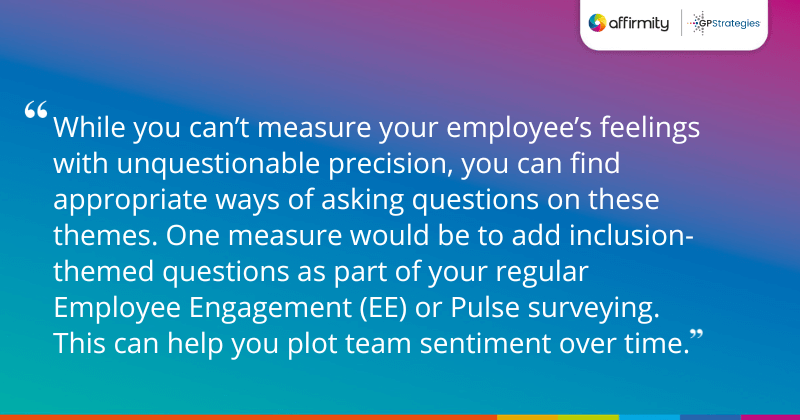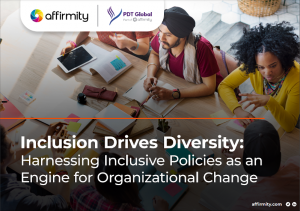Diversity and Inclusion are terms that seem inseparable from each other when organizations talk about their workforces. There’s no D without I, but are they always given equal weighting? Read on to discover the statistical case for inclusion, and how to measure your efforts in order to make that case in your own organization.
How Inclusion—Although Essential—Is Often Overlooked
The Harvard Business Review describes the situation succinctly:
“Most business leaders understand the diversity part of diversity and inclusion. They get that having a diverse workforce is important to customers and critical to succeeding in a global market. It’s the inclusion part that eludes them—creating an environment where people can be who they are, that values their unique talents and perspectives, and makes them want to stay.”
The phrase “diversity & inclusion” perhaps unhelpfully frontloads the end-goal of DE&I: an organization that’s visibly and measurably diverse and reaping the full rewards of that diversity for all involved. Unfortunately, focusing on diversity alone leads to having all the right people in the mix but fails to ensure that those hires feel genuinely welcomed and able to contribute to their full potential.
An organization in that situation is like a punctured tire—you can keep pumping air into it, and with a lot of effort it may even be possible to fill it up all the way. However, just a short while later, it’ll be back to how it was before. There’s probably no shortage of organizations that have continued to push fresh personnel into this punctured tire when it would have taken a lot less effort to remove the thumbtack that was causing their predecessors to leave.
MORE INSIGHTS ON INCLUSIVITY | ‘5 Inclusive Mindsets That Create Better Businesses for Employees With Disabilities’

Making the Case for Inclusion
Like a lot of DE&I principles, building inclusion makes intuitive sense: we want employment that’s responsive to our needs and priorities, and understand that others would want the same. The business case is more elusive and worth reiterating.
Better Business Outcomes
Deloitte’s research into the better business outcomes of organizations combining diversity and inclusion acknowledges that inclusion itself is “often left to personal interpretation” with many organizations “unclear about what it means”. Deloitte defines inclusion using four key areas:
- Being treated with fairness and respect
- Feeling valued and belonging to the group
- Feeling safe to contribute openly
- Being empowered to grow and achieve
With these measurements established, it then suggests that organizations with inclusive cultures are:
- 2x as likely to meet or exceed financial targets
- 3x as likely to be high-performing
- 6x more likely to be innovative and agile
- 8x more likely to achieve better business outcomes
The research additionally highlights how inclusive leadership behavior results in a:
- 70% increase in reported experiences of fairness, respect, value, belonging, psychological safety, and inspiration by individuals
- 17% increase in team performance
- 20% increase in team decision-making quality
- 29% increase in team collaboration
It makes sense to bring all of this together and offer a more specific definition—and one that can be used to hold leaders to account. Ultimately, we’re creating an environment where everyone with the capability to succeed can do so.

Impact of the Absence of Inclusion
Inclusivity is an important factor in what attracts workers to an organization—and what keeps them there.
Deloitte’s research suggests that 39% of respondents would leave their current organization for a more inclusive one. Millennials are particularly motivated by inclusivity—53% stated that they would leave in the absence of it, and nearly one-third claimed to have already done so.
When organizations fail to foster inclusion, it makes sense that a higher rate of turnover follows. Reducing avoidable turnover is always a sensible goal: the knowledge and morale loss when an employee leaves is not negligible, and the more frequently you’re hiring a replacement, the more time and money you spend.
Gallup estimates that US businesses lose around one trillion dollars annually to avoidable turnover, and that replacing an individual employee costs between one half to twice their salary. Despite this:
- 52% of employees who choose to leave say that their manager or organization could have done something to prevent them from leaving.
- 51% say that no one in a leadership position discussed with them their job satisfaction or future in the organization in the three months leading up to their exit.
This lack of communication with concerned employees is broadly an inclusion problem. As the article puts it, “nobody talked about their future. So it makes sense that they decided they didn’t have one there.”
However, while having “frequent, meaningful conversations with employees about what really matters to them” can help mitigate an employee’s sense of feeling unvalued, it isn’t a cure-all. Among that 48% who say that there was nothing anyone could have done to keep them there are surely many who had felt unfairly treated, or unable to safely and openly contribute, for most of their tenure.
But at some point, talking simply isn’t enough…
MORE ON THE BUSINESS CASE FOR DE&I | ‘The Case for Accelerating Diversity, Equity, and Inclusion [By the Numbers]’
How to Measure Your Progress
The business case for DE&I has been made again and again in studies and reports big and small. However, if it cannot be demonstrated in your own organization, those arguments are only so effective. The tools and approaches for measuring diversity and equity are readily available—and reporting on how inclusion is making sure that your gains are sticking should also be a priority.
Reporting and Benchmarking Representation
Measuring representation across your organization is a matter of surveying the characteristics of people in different roles, departments, and offices. You may already be doing some of this work for compliance purposes: for example, US federal contractors may already collect information on gender, race, disabilities, and veteran status.
You should start by determining what data you’re already collecting, and which groups or areas of the business could be added to the dataset for a complete view. Bear in mind that providing information about most characteristics is completely optional for your employees. Be prepared to explain why it’s important that you collect certain data, and the limits of how that data will be used.
Processing and drawing conclusions from this data will be considerably easier with a solution such as Affirmity’s Diversity benchmarking and reporting tools. Being able to see a clear graphical visualization of your workforce demographics at all levels will better help you address shortfalls and start taking action.

Reporting and Monitoring Inclusion
Measuring representation will help you to chart the progress of your organization’s diversity initiatives, and combining that data with compensation will allow you to start creating a more equitable environment. But what about inclusion? Considering how critical it is for sustaining diversity and equity, it can and should be measured.
Earlier, we considered a model for inclusivity suggested by Deloitte, which proposed that inclusion meant:
- Being treated with fairness and respect
- Feeling valued and belonging to the group
- Feeling safe to contribute openly
- Being empowered to grow and achieve
While you can’t measure your employee’s feelings with unquestionable precision, you can find appropriate ways of asking questions on these themes. One measure would be to add inclusion-themed questions as part of your regular Employee Engagement (EE) or Pulse surveying. This can help you plot team sentiment over time, provided you once again make employees aware of why you’re asking and make it safe for them to tell you what they truly feel.
Outside of this, it’s important to monitor retention rates relative to other groups in your organization. If employees with certain characteristics leave more quickly, this requires further investigation.
MORE ON MEASUREMENT FROM THE BLOG | ‘Do You Know Your Diversity Numbers? The Value of Intersectionality, Benchmarking, and Beyond’
Inclusion Drives Diversity—Keep Reading
These insights into inclusion’s powerful influence on organizational diversity, and how to measure the progress you make, come from our latest ebook: “Inclusion Drives Diversity: Harnessing Inclusive Policies as an Engine for Organizational Change”. Download the full guide and keep reading analysis from our experts on:
- Why you need to review your hiring and promotion practices
- The link between inclusion, retention, and diversity
- Multigenerational and multicultural inclusion tactics to drive inclusivity
- Pay equity’s continuing role alongside diversity and inclusion
Download the full guide today.

